
Photographs by Katy Grannan

Editor’s note: This article is part of a new series called “Who Owns America’s Wilderness?”
Image above: Glacier National Park, in Montana, as seen from the Blackfeet Reservation, near Duck Lake.
This article was published online on April 12, 2021.

In 1851, members of a California state militia called the Mariposa Battalion became the first white men to lay eyes on Yosemite Valley. The group was largely made up of miners. They had been scouring the western slopes of the Sierra when they happened upon the granite valley that Native peoples had long referred to as “the place of a gaping mouth.” Lafayette Bunnell, a physician attached to the militia, found himself awestruck. “None but those who have visited this most wonderful valley, can even imagine the feelings with which I looked upon the view,” he later wrote. “A peculiar exalted sensation seemed to fill my whole being, and I found my eyes in tears.” Many of those who have followed in Bunnell’s footsteps over the past 170 years, walking alongside the Merced River or gazing upon the god-rock of El Capitan, have been similarly struck by the sense that they were in the presence of the divine.
The Mariposa Battalion had come to Yosemite to kill Indians. Yosemite’s Miwok tribes, like many of California’s Native peoples, were obstructing a frenzy of extraction brought on by the Gold Rush. And whatever Bunnell’s fine sentiments about nature, he made his contempt for these “overgrown, vicious children” plain:
Any attempt to govern or civilize them without the power to compel obedience, will be looked upon by barbarians with derision … The savage is naturally vain, cruel and arrogant. He boasts of his murders and robberies, and the tortures of his victims very much in the same manner that he recounts his deeds of valor in battle.
When the roughly 200 men of the Mariposa Battalion marched into Yosemite, armed with rifles, they did not find the Miwok eager for battle. While the Miwok hid, the militiamen sought to starve them into submission by burning their food stores, souring the valley’s air with the smell of scorched acorns. On one particularly bloody day, some of the men came upon an inhabited village outside the valley, surprising the Miwok there. They used embers from the tribe’s own campfires to set the wigwams aflame and shot at the villagers indiscriminately as they fled, murdering 23 of them. By the time the militia’s campaign ended, many of the Miwok who survived had been driven from Yosemite, their homeland for millennia, and forced onto reservations.
Thirty-nine years later, Yosemite became the fifth national park. (Yellowstone, which was granted that status in 1872, was the first.) The parks were intended to be natural cathedrals: protected landscapes where people could worship the sublime. They offer Americans the thrill of looking back over their shoulder at a world without humans or technology. Many visit them to find something that exists outside or beyond us, to experience an awesome sense of scale, to contemplate our smallness and our ephemerality. It was for this reason that John Muir, the father of modern conservationism, advocated for the parks’ creation.
[From the August 1897 issue: John Muir’s “The American Forests”]
More than a century ago, in the pages of this magazine, Muir described the entire American continent as a wild garden “favored above all the other wild parks and gardens of the globe.” But in truth, the North American continent has not been a wilderness for at least 15,000 years: Many of the landscapes that became national parks had been shaped by Native peoples for millennia. Forests on the Eastern Seaboard looked plentiful to white settlers because American Indians had strategically burned them to increase the amount of forage for moose and deer and woodland caribou. Yosemite Valley’s sublime landscape was likewise tended by Native peoples; the acorns that fed the Miwok came from black oaks long cultivated by the tribe. The idea of a virgin American wilderness—an Eden untouched by humans and devoid of sin—is an illusion.
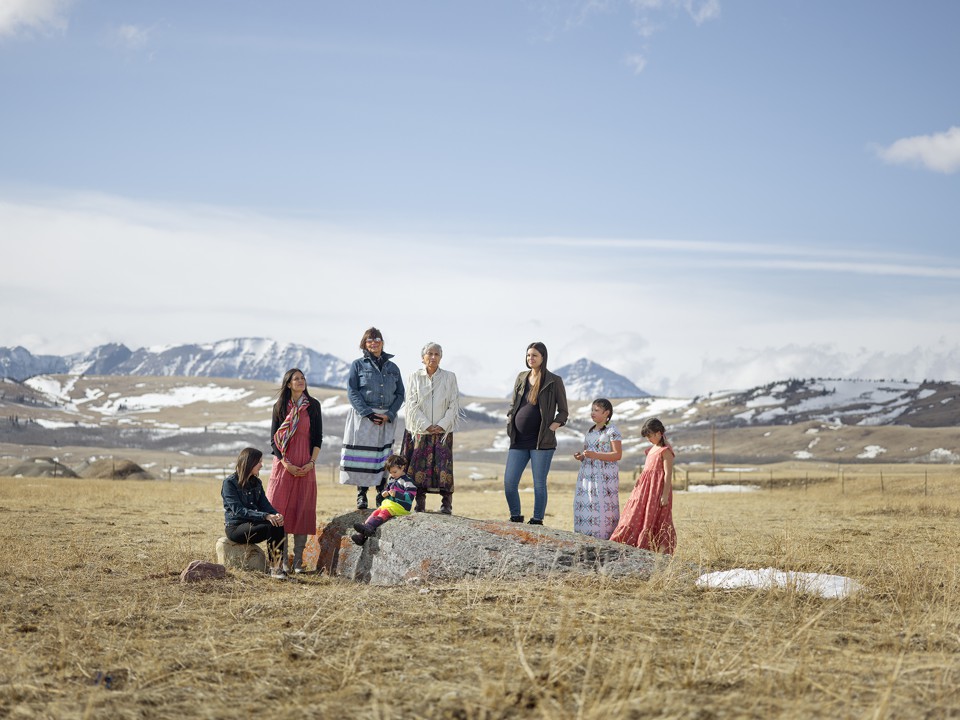
The national parks are sometimes called “America’s best idea,” and there is much to recommend them. They are indeed awesome places, worthy of reverence and preservation, as Native Americans like me would be the first to tell you. But all of them were founded on land that was once ours, and many were created only after we were removed, forcibly, sometimes by an invading army and other times following a treaty we’d signed under duress. When describing the simultaneous creation of the parks and Native American reservations, the Oglala Lakota spiritual leader Black Elk noted darkly that the United States “made little islands for us and other little islands for the four-leggeds, and always these islands are becoming smaller.”
Many of the negotiations that enabled the creation of these islands took place in English (to the disadvantage of the tribes), when the tribes faced annihilation or had been weakened by disease or starvation (to the disadvantage of the tribes), or with bad faith on the part of the government (to the disadvantage of the tribes). The treaties that resulted, according to the U.S. Constitution, are the “supreme Law of the Land.” Yet even despite their cruel terms, few were honored. Native American claims and rights were ignored or chipped away.
The American story of “the Indian” is one of staggering loss. Some estimates put the original Indigenous population of what would become the contiguous United States between 5 million and 15 million at the time of first contact. By 1890, around the time America began creating national parks in earnest, roughly 250,000 Native people were still alive. In 1491, Native people controlled all of the 2.4 billion acres that would become the United States. Now we control about 56 million acres, or roughly 2 percent.
[Read: The Blackfeet brain drain]
And yet we remain, and some of us have stayed stubbornly near the parks, preserving our attachment to them. Grand Canyon National Park encloses much of the Havasupai Tribe and its reservation. Pipe Spring National Monument sits entirely inside the 120,000-acre Kaibab Paiute Indian Reservation, in northern Arizona. Many other parks neighbor Native communities. But while the parks may be near us, and of us, they are not ours.
We live in a time of historical reconsideration, as more and more people recognize that the sins of the past still haunt the present. For Native Americans, there can be no better remedy for the theft of land than land. And for us, no lands are as spiritually significant as the national parks. They should be returned to us. Indians should tend—and protect and preserve—these favored gardens again.
In July 2020, I conducted something of a barnstorming tour. I wanted to look with fresh eyes at the park system, to imagine a new future for it. I had planned on visiting all sorts of places—the Grand Canyon, Yosemite, Great Smoky Mountains National Park—but the coronavirus pandemic intervened.
Some parks closed completely, while others (like Yellowstone) closed campgrounds, cultural centers, and museums. In the end I drove from Minnesota through North Dakota, Montana, Wyoming, Idaho, and Oregon and down the spine of California. Then I turned around and drove back. I visited Theodore Roosevelt National Park, Little Bighorn Battlefield, Yellowstone, Grand Teton, Mount Hood National Forest, Kings Canyon, Death Valley, and Joshua Tree.
The roads were quieter than usual, though the skies were sometimes hazy as the West Coast burst into flames. I slept in campgrounds, in my tent in the backyards of friends, and, rarely, in a hotel or motor lodge. I cooked on the trunk of my car and on picnic tables, under the blazing sun and in torrential rain. I fought off raccoons and squirrels.
More than any other place I visited, Yellowstone seemed to contain the multitudes of America. There, I saw elk and bison. I saw enough recreational vehicles to house a good portion of this country’s homeless. I saw lake water, river water, black water, swamp water, and frothy waterfall water. I saw Tony Hawk being stopped by two park rangers after longboarding down the switchbacks above Mammoth Hot Springs while an actual hawk circled above him. I saw Instagram models in tiny bikinis posing in front of indifferent bison. I saw biker gangs (who seem to really enjoy parks) and gangs of toddlers (who don’t seem to enjoy anything). I saw tourists, masked and unmasked. I saw placards and displays. I discovered that you can learn a lot about nature at Yellowstone, and perhaps even more about American culture. But the park’s official captions give you at best a limited sense of its human history.
Yellowstone National Park was created about 100 years after the country was born. An 1806 expedition, part of Lewis and Clark’s Corps of Discovery, passed just north of where the park is today. Later, John Colter, one of the Corps members, joined the fur trade and purportedly became the first non-Native to see its vistas. Of course, Native people had lived there for thousands of years, and at the time Colter was setting traps in the area, they still claimed Yellowstone as their home.
Colter traveled through the Yellowstone area and the Teton Range in the early 19th century, looking for fur. Wherever he went, he ended up in mortal conflict with Native Americans, culminating in his wounding at the hands of the Blackfeet. He hid from the tribe under a pile of driftwood and then walked for a week to safety. Over the next 60 years, trappers like him described the landscape that would become Yellowstone as an area of mud geysers, acid pools, and petrified trees.
Not until 1869 did the first official expedition explore the region and confirm the mountain men’s accounts. Things moved quickly after that. In 1871, Ferdinand V. Hayden led a government-sponsored survey of Yellowstone that produced reports complete with professional sketches and photographs. Based on that report, President Ulysses S. Grant signed into law the Yellowstone Act of 1872, which created America’s first landscape to be “reserved and withdrawn from settlement, occupancy, or sale … and dedicated and set apart as a public park or pleasuring-ground for the benefit and enjoyment of the people.”
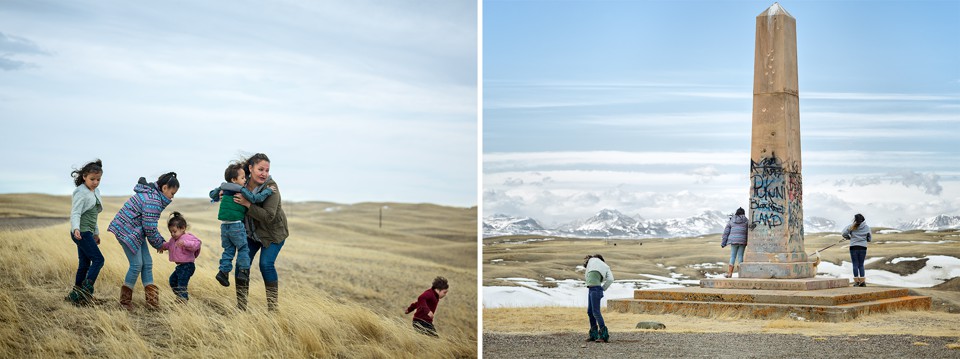
Grant’s declaration made trespassers of the Shoshone, Bannock, and other peoples who had called the parkland home for centuries. The tribes left with the understanding that they would retain hunting rights in the park, as guaranteed by an 1868 treaty. Before the century was out, however, the government had reneged on that promise. This tactic of theft by broken treaty would become a pattern where parks were concerned.
When Yellowstone was established, the Plains Wars were raging all around the park’s borders. It was as though the government paused mid-murder to plant a tree in the victims’ backyard. The Dakota War had erupted 10 years earlier, just east of the Great Plains. By the time it was over, dozens of Dakota had been hanged, and more than 1,600 women, children, and elders had been sent to a concentration camp at Fort Snelling. Eventually, all of the treaties between the Eastern Dakota and the U.S. government were “abrogated and annulled.”
[Read: ‘Kill every buffalo you can! Every buffalo dead is an Indian gone’]
In 1864, on the Plains’ opposite edge, at Sand Creek in Colorado Territory, Colonel John Chivington massacred and mutilated as many as 500 Native Americans. In 1868, just four years before the creation of Yellowstone, Native Americans, led by Red Cloud, fought the U.S. government to a standstill, then forced concessions from the Americans at the treaty table, though these, too, were eventually unmade.
War came to Yellowstone itself in 1877. Chief Joseph’s band of Nez Perce had been shut out of their homeland in the Wallowa Valley and embarked on a 1,500-mile journey that would end just south of the Canadian border, where they would surrender to the U.S. Army. The Nez Perce did their best to avoid white people on their way. But they were attacked on the banks of the Big Hole River, in August 1877, by soldiers in Colonel John Gibbon’s command. Gibbon’s men approached the camp on foot at dawn, killing a man during their advance. Then they began firing into the tepees of the sleeping Nez Perce, killing men, women, and children. The Nez Perce counterattacked. Their warriors kept Gibbon’s soldiers pinned down while the others escaped. Although they defended themselves well, they lost at least 60 people.
Reeling from these deaths, the Nez Perce passed into Yellowstone, where they ran into tourists from Radersburg, Montana, enjoying the “pleasuring-ground” created at the expense of Indians. The Nez Perce briefly held the tourists hostage, and then released them, but went on to kill two tourists in the park later in the month.
Moving east through the park, the tribe forded the Yellowstone River at a place still known as the Nez Perce Ford. Around the time they crossed the river, an elderly woman peeled away from the main column and stayed at an area known as Mud Volcano. She sat on a bison robe near a geyser and sang. When a U.S. scout approached her, she closed her eyes. “She seemed rather disappointed,” John W. Redington, the scout, wrote, “when instead of shooting her I refilled her water bottle. She made signs that she had been forsaken by her people, and wanted to die.” Ten minutes later, a Bannock scout for the Army obliged by striking her down and scalping her. One hundred and forty-three years later, my sons and daughter and I would stand on the same spot, wondering why there are so few places in the park where you can learn about its bloody past. Viewed from the perspective of history, Yellowstone is a crime scene.
America’s national parks comprise only a small fraction of the land stolen from Native Americans, but they loom large in the broader story of our dispossession. Most of the major national parks are in the western United States. So, too, are most Native American tribes, owing to the Indian Removal Act of 1830, which attempted to eject all tribes east of the Mississippi to what was then Indian Territory. The reservation period likewise began, for the most part, in the West, in the mid-19th century.
[From the May 2020 issue: The people who profited off the Trail of Tears]
Even after we were relegated to reservations, the betrayals continued. Beginning in 1887, the Dawes Act (also known as the General Allotment Act) split much of the reservations up into small parcels of land to be granted to individual Indians, while the “surplus” communal land was opened for white settlement. In blunt terms, Thomas Morgan, the commissioner of Indian affairs, said in 1890 that the goal of federal policy at the time was “to break up reservations, destroy tribal relations, settle Indians upon their own homesteads, incorporate them into the national life, and deal with them not as nations or tribes or bands, but as individual citizens.” This land grab bled at least another 90 million acres away from the tribes—roughly equivalent to the 85 million acres that comprise America’s 423 national-park sites.
After Yellowstone was established and Indians were removed and in some cases excluded from its spaces, the same—and worse—happened elsewhere. The Blackfeet, living in three bands in northwestern Montana and southern Alberta, had long thought of the Rockies as their spiritual and physical homeland. They wouldn’t have dreamt of ceding it at the treaty table, but in the 1880s and ’90s, they were forced to negotiate with the U.S. government. Weakened by a string of epidemics, seasons of starvation, and insatiable Americans bent on opening up their homelands to timber and mineral extraction, the Blackfeet had to make concession after concession. Some years, they had to give up land just to secure enough resources to last through the next winter.
Not long after a harsh winter that killed as many as 600 Blackfeet, the tribe signed away land that would become Glacier National Park. The deal was brokered by George Bird Grinnell, the naturalist founder of the Audubon Society of New York. Grinnell had joined George Armstrong Custer on his expedition into the Black Hills in 1874 in search of gold. The trip was in direct violation of the treaty guaranteeing that the Black Hills would remain in Native control. Grinnell was often called a “friend of the Indian,” but he once wrote that Natives have “the mind of a child in the body of an adult.” In 1911, a year after Congress approved the creation of Glacier, Montana ceded jurisdiction of the park to the U.S. government.
[Read: How much are America’s national parks worth?]
So many of the parks owe their existence to heists like these. Apostle Islands National Lakeshore, in Wisconsin, was created out of Ojibwe homelands; the Havasupai lost much of their land when Grand Canyon National Park was established; the creation of Olympic National Park, in Washington, prevented Quinault tribal members from exercising their treaty rights within its boundaries; and Everglades National Park was created on Seminole land that the tribe depended on for food. The list goes on.
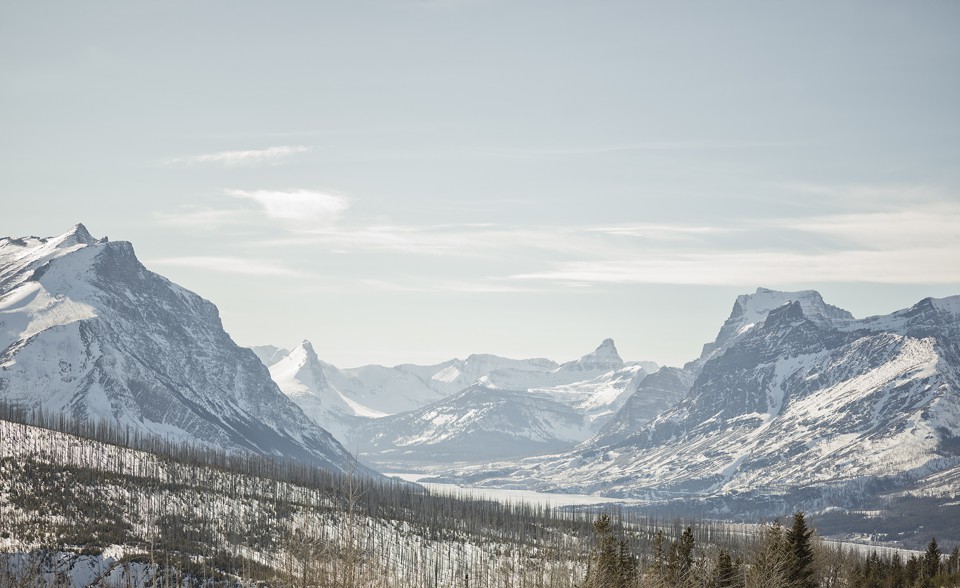
I set out on my trip through America’s national parks from my home, at Leech Lake Reservation, in Minnesota, on the southern fringe of the North American boreal forest. This forest is one of the largest stretches of woodland in the world: It spreads from the Aleutian Islands all the way to Newfoundland and from near the southern edge of Hudson Bay to northern Minnesota, Wisconsin, and Michigan. As I headed west for Theodore Roosevelt National Park, in North Dakota, the taiga gave way to grasslands and oak savanna near Detroit Lakes, Minnesota. By the time I crossed the Red River, I’d left the forest behind altogether. I felt the land dip, and looking west, I thought I could make out the horizon where the Great Plains begin.
As a boy, I would accompany my father on business trips through some of these same landscapes. In the car, he would narrate the history of our region, mostly without much emotional inflection: “Chief Little Crow fled this way to escape the military after the Dakota War in 1862.” We would pass many small towns—Hawley, Valley City, Medina, Steele—that seemed pleasant enough, until my father ruined them for me. The calm and order of them, their small houses and neatly kept yards, the Protestant ethic reflected in their organization—all of it infuriates me, because every single one of those towns exists at our expense.
Medora, North Dakota, is the southern gateway to Theodore Roosevelt National Park. (The Marquis de Morès named the town after his wife, Medora von Hoffman, though the romance of the gesture suffers when you consider that he established the town as a place to slaughter cattle to be sold at eastern markets.) Medora today is a fantasy of a time that never was. There is a statue of Roosevelt and a Rough Riders Hotel and, during the summer months, the Medora Musical. The show’s website really says it best when it promises “the rootin’-tootinest, boot-scootinest show in all the Midwest. There’s no other show quite like it. It’s an ode to patriotism, Theodore Roosevelt, and the Great American West!” When I was there it was an ode to COVID‑19: According to a clerk at the convenience store, one of the cast members was spreading the virus from the stage.
I wanted to begin my journey at Theodore Roosevelt because no one embodies the tensions of the park system as it is currently constituted like the 26th president. Contained in the person of Roosevelt was a wild love for natural vistas and a propensity for violent imperialism; an overwhelming desire for freedom and a readiness to take it away from other people. Much of the park named after him exists on top of Mandan, Hidatsa, and Arikara (MHA) land. The MHA lost that land in 1851, with the signing of the first Treaty of Fort Laramie. Executive orders in 1870 and 1880 seized still more of the tribes’ homeland.
Roosevelt went to hunt bison in Dakota Territory in 1883. In 1884, when he was back home in New York, his wife gave birth to their daughter, Alice, but unbeknownst to her doctors, his wife had a kidney ailment, and died on Valentine’s Day that year. Teddy’s mother died the same day in the same house. After drawing a large X in his diary, Roosevelt wrote, “The light has gone out of my life.” He returned to the West and built a ranch outside Medora, intent on letting nature soothe him. He didn’t last long out there, and the West never became his permanent home, but it left a mark on him—and he, in turn, left his mark on it.
[From the May 1906 issue: Camping with President Theodore Roosevelt]
Roosevelt was familiar with Native Americans, having interacted with them when he was in Dakota Territory. “The most vicious cowboy has more moral principle than the average Indian,” he would say in an 1886 speech, during which he also famously declared: “I don’t go so far as to think that the only good Indians are the dead Indians, but I believe nine out of every 10 are, and I shouldn’t like to inquire too closely into the case of the tenth.”
Roosevelt’s attitude toward Indians is manifest in his treatment of the Apache leader Geronimo. Born in 1829, Geronimo lived the first three decades of his life in the peace and security of his Apache homelands, in what is now New Mexico and Arizona. In the second half of the 19th century, he rose to international fame for fighting the American and Mexican governments in an attempt to preserve his tribe’s piece of the Southwest.
In 1858—the year of Roosevelt’s birth—Geronimo joined a large trading party that left the Mogollon Mountains and entered Mexico. While he was in town conducting business, his band was attacked and slaughtered at camp. Among the dead were Geronimo’s wife, mother, and three small children. He later recalled, “I did not pray, nor did I resolve to do anything in particular, for I had no purpose left.” Life, for him, as recounted by Gilbert King in Smithsonian magazine, shaded from peace into a state of perpetual warfare, ending only with his capture by U.S. forces in 1886, around the time Roosevelt was mourning in Dakota Territory.
Geronimo was shipped east and spent the rest of his life in captivity, and his tribe’s land was whittled away. Around the same time, Native children were also being shipped away from their homelands, to government-sponsored boarding schools—removed from their families and their culture so as to mainstream them. Attendance was sometimes mandated by law and sometimes coerced, but it was rarely strictly voluntary. For speaking in their own language, the children were sometimes beaten or had soap put in their mouths. Of the 112 Apache children from Geronimo’s band sent to the Carlisle Indian Industrial School, in Pennsylvania, 36 died—most of them likely from tuberculosis—and were buried there.
For his part, Geronimo did get out (under guard) once in a while, including a stint in 1904 as part of the “Apache Village” at the St. Louis World’s Fair, where he was made to play the role of the savage. In 1905, he and other Native leaders were asked to be part of Roosevelt’s inaugural parade. It was a who’s who of tribal leadership, including Quanah Parker (Comanche), Buckskin Charlie (Ute), Hollow Horn Bear (Brulé Lakota), American Horse (Oglala Lakota), and Little Plume (Piegan Blackfeet). They rode horses down Pennsylvania Avenue in regalia not entirely in step with their individual tribal traditions. America liked and still likes its Indians to function much like its nature: frozen in time; outside history; the antithesis, or at best the outer limit, of humanity and civilization.
Geronimo met with Roosevelt afterward. “Take the ropes from our hands,” he begged, in a desperate appeal to be allowed to return, along with other Apache prisoners, to his homeland. Roosevelt declined, telling him, “You killed many of my people; you burned villages.” Geronimo began to gesture and yell but was cut off. Four years later, he died in captivity at Fort Sill, Oklahoma.
In 1903, Roosevelt had let himself be drawn back west. In April of that year he embarked on a 14,000-mile train journey that took him through 24 states and territories in nine weeks. He traveled to Yellowstone, the Grand Canyon, and California, where he enjoyed a three-night camping trip with John Muir.
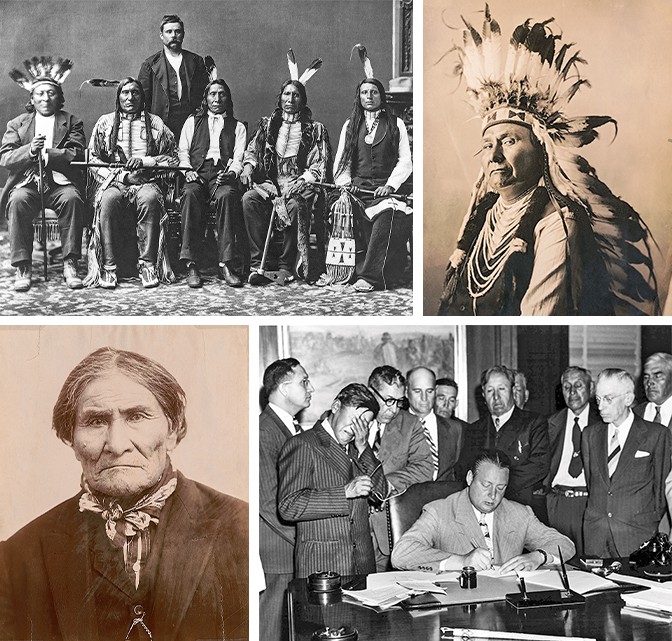
Bottom left: Geronimo at the St. Louis World’s Fair, in 1904. Bottom right: George Gillette (left), the chairman of the Fort Berthold Indian Tribal Business Council, weeps as more than 150,000 acres of the Fort Berthold Reservation in North Dakota are signed away for the Garrison Dam and Reservoir project. (Bettmann / Getty; De Lancey Gill / Library of Congress; The Gerhard Sisters / Library of Congress; William Chaplis / AP)
Along the way, Roosevelt gave speeches—at the Grand Canyon; at Yellowstone, where he laid the cornerstone for the Roosevelt Arch; near some redwoods in Santa Cruz. He said much about the majesty of nature. Regarding the Grand Canyon: “I want to ask you to do one thing in connection with it in your own interest and in the interest of the country—to keep this great wonder of nature as it now is … I hope you will not have a building of any kind, not a summer cottage, a hotel or anything else, to mar the wonderful grandeur, the sublimity, the great loneliness and beauty of the canyon.” And Yellowstone: “The Yellowstone Park is something absolutely unique in the world, so far as I know … The scheme of its preservation is noteworthy in its essential democracy … This Park was created, and is now administered, for the benefit and enjoyment of the people.”
Roosevelt translated his passions into policy. During his time in office, he created 150 national forests, 18 national monuments, five national parks, four national game preserves, and 51 bird “reservations.”
Like Geronimo, Roosevelt came of age during a pivotal 50-year stretch when the contiguous United States assumed its final dimensions. The last major armed conflict between a Native tribe and the U.S. government ended at Wounded Knee Creek with the massacre of as many as 300 men, women, and children of Spotted Elk’s band of Miniconjou. The frontier was pushed all the way to the Pacific and then was no more, and America’s truly wild space—land outside the embrace of “civilization”—was subsumed.
The American West began with war but concluded with parks.
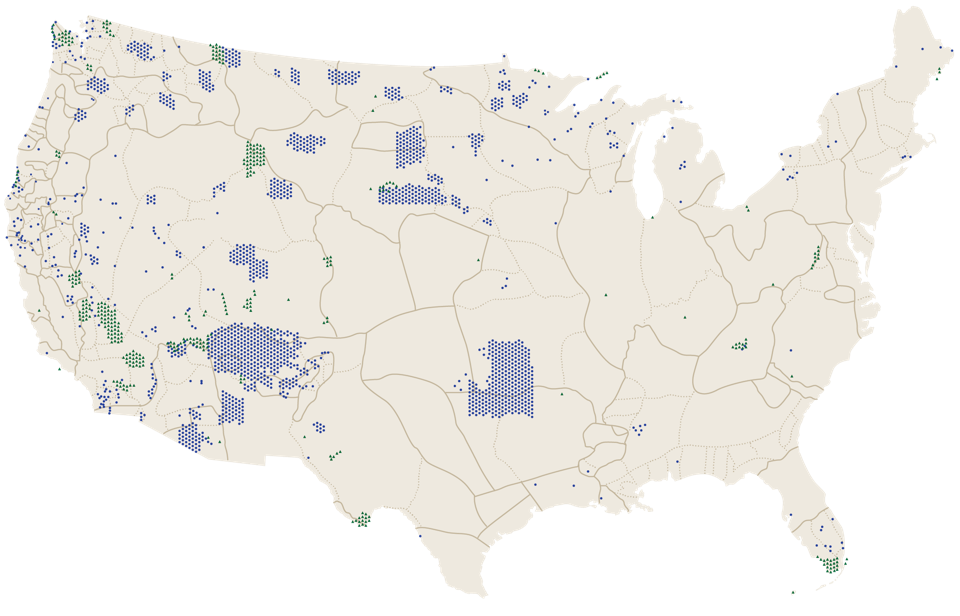

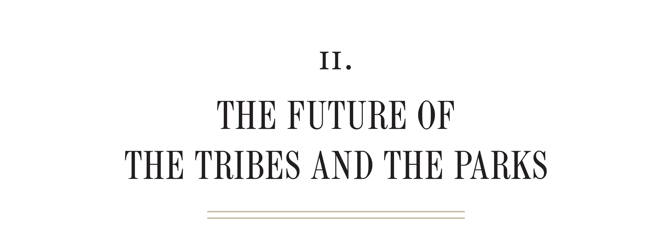
The MHA Nation lives just north and a little east of Theodore Roosevelt National Park, but under drastically different circumstances than the people in and around Medora. Time and again, the MHA reservation was reduced by federal fiat and exploitative deals—from more than 12 million acres to less than 1 million. The dispossessions continued well into the 20th century: During construction of the Garrison Dam and Reservoir on the Missouri River in the 1940s and ’50s, up to 80 percent of the reservation population was forced to relocate away from the fertile river bottoms that had given them life and defined them as a people for centuries.
In the 1860s, long before the dam was built, the MHA had lived mostly at a place called Like-a-Fishhook Village, Royce Young Wolf, the collections manager at a new cultural center the MHA are building, told me. “It’s all under the lake now, flooded out,” she said. We were standing at Oxbow Overlook inside the park, looking down at the Little Missouri River as it wound lazily through acres of cottonwood and grassy clearings. “They were self-sufficient,” she said. “Each village had its own garden. Many families had sacred bundle-keepers.” The dam was planned without any meaningful consultation of the MHA Nation; after the Army Corps of Engineers threatened to confiscate the land it needed, citing eminent domain, the tribes had little choice but to come to the negotiating table and eventually cede territory. By 1949, they had received settlements totaling only $12.6 million for the more than 150,000 acres that were taken.
“They moved us from where water was plentiful to where there wasn’t any,” Young Wolf said. “Our river bottoms were the most fertile in the whole state … But when we were flooded, we were moved to areas where there’s poor soil and no water and we couldn’t sustain large gardens.” The tribes’ rights to use the land on the reservoir’s shoreline—for hunting or fishing or plant-gathering—were denied.
In recent years, the MHA have been in the grip of rapid, violent, and remunerative fracking enterprises. As I drove north from the park, I saw land bearing scars—pipes, gas vents, and fracking pads dotting the hills. In 2014, the former tribal chair Tex Hall promised the tribes “sovereignty by the barrel,” and he wasn’t wrong: The tribes are wealthier than they have been since before the first Treaty of Fort Laramie. But by encouraging and facilitating oil extraction, they put themselves at odds with their own cultural legacy and connection to the land.
Native American nations such as the MHA are in a difficult position. They have endured state-sponsored assaults on their families, communities, land, and ways of life. Their traditional political structures and institutions have suffered under the paternalism of the Bureau of Indian Affairs, which controls Native land by holding it in trust.
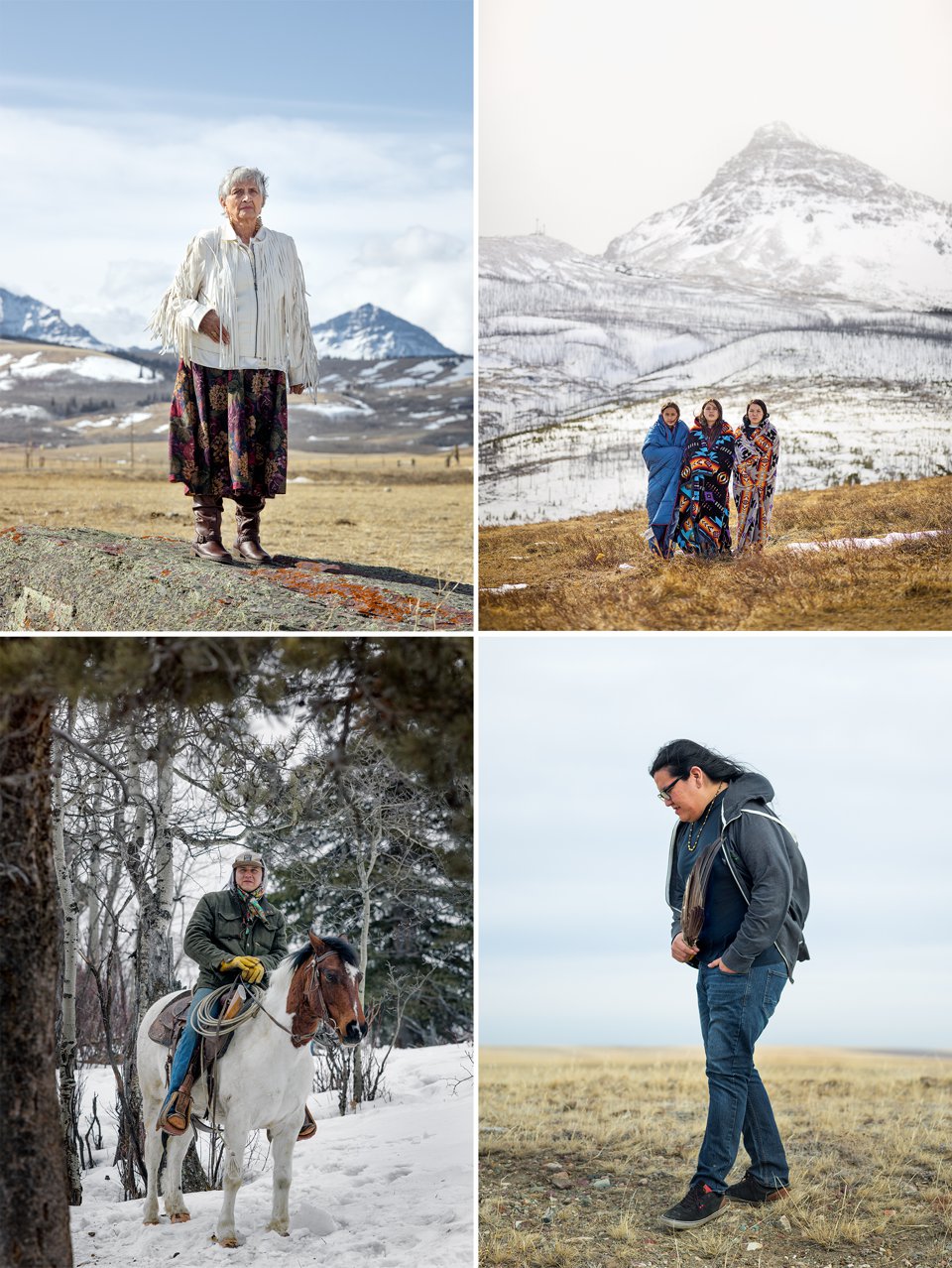
Bottom left: Doug Fitzgerald on his grandfather’s ranch on the Blackfeet Reservation. Bottom right: Michael Fast Buffalo Horse, a traditional artist and singer, at Camp Disappointment.
On one hand, we are sovereign nations with our own laws and law enforcement, courts, and municipal infrastructures, all derived from those rights that we have managed to retain. Contrary to popular myth, neither casinos nor the right to gamble were “given” to tribes as a kind of pity payment or as the recognition of a debt owed us. The casino industry is the modern expression of a civil right to gamble that we had before white people came along, a right we have retained and that was affirmed by the Supreme Court.
[Read: One way to help Native Americans: Property rights]
On the other hand, without a strong tax base or much commerce—extractive industries, casino gambling, and tax-free cigarette sales are notable exceptions—we are dependent on federal support for education, health care, infrastructure, and our continued survival. We are, in the words of Chief Justice John Marshall, “domestic dependent nations,” and thus live in constant tension.
The MHA have had their struggles—with unemployment, substance abuse, a destructive marriage to the oil-and-gas industry, and intergenerational trauma inflicted by the U.S. government. But tribes are much more than the sum of their troubles. The MHA are also keenly protective of their heritage and culture. The cultural center they are constructing is a state-of-the-art facility in service to these ideals.
The MHA Interpretive Center is on Army Corps of Engineers land because that land is near the river, which is so essential to MHA history, Delphine Baker, the director of the Interpretive Center, told me. She was instantly recognizable to me as a kind of fierce, no-nonsense Native auntie. Government officials didn’t want the tribes to own that land, she said matter-of-factly—the tribes now hold a lease instead—out of a concern that the tribes would take control of recreation rights and not allow nontribal members to have access. “The tribe never is interested in blocking access. But, you know, that’s a fear.”
The facility is gorgeous—swooping embankments and curving walks mirror the rolling hills and grasslands of the MHA tribal area. Inside is a partial replica of an earth lodge, the traditional dwelling of the three tribes, and gallery space that tells the story of the MHA. The Interpretive Center will be the home for hundreds, if not thousands, of artifacts taken from the tribes over the years. And it will not be merely a show-and-tell kind of endeavor. The center will cultivate traditional plants on a rooftop garden. A café will serve traditional foods. There is a recording studio for preserving tribal languages, and a research space where tribal members will be able to trace their lineage. For so many Native people who have been separated from their tribes because of federal meddling, reconnecting is an important service the center can provide. To call this an Interpretive Center isn’t quite right. It is more like a cultural mothership.
“If you lose your culture, you lose your sovereignty and your tribe,” Baker told me. “And that’s what we’re fighting against.”
It is not the first such fight. During the early reservation period, a difficult and fractious time when the people at Like-a-Fishhook Village were trying to figure out a new way of living, a splinter group wanted to hunt and garden in the old communal ways. So they left, relocating outside the reservation, about 120 miles upriver. “That group became known as the Xoshga, and they were led by Crow Flies High and Bobtail Bull,” Young Wolf told me. “When they separated, they were taking a stand against assimilation and Christianity. They stayed away for over 20 years.” They revived ceremonies and songs and dances. They preserved knowledge of local plants. While they were gone, Young Wolf said, the community at Like-a-Fishhook Village suffered from being split apart into small plots of land. But the Xoshga “kept our traditions safe while they were away. And it’s because of them we have many of our traditions today.”
In 1894, the government forced the Xoshga back to the reservation. They were treated badly at first by many of the MHA members who had stayed behind, Young Wolf told me. They were looked at as backward and savage. But now, to be Xoshga is to be connected to the land, to tradition, and to a spirit of resistance. The Xoshga were saved by the land, and their return to it saved their tribe.
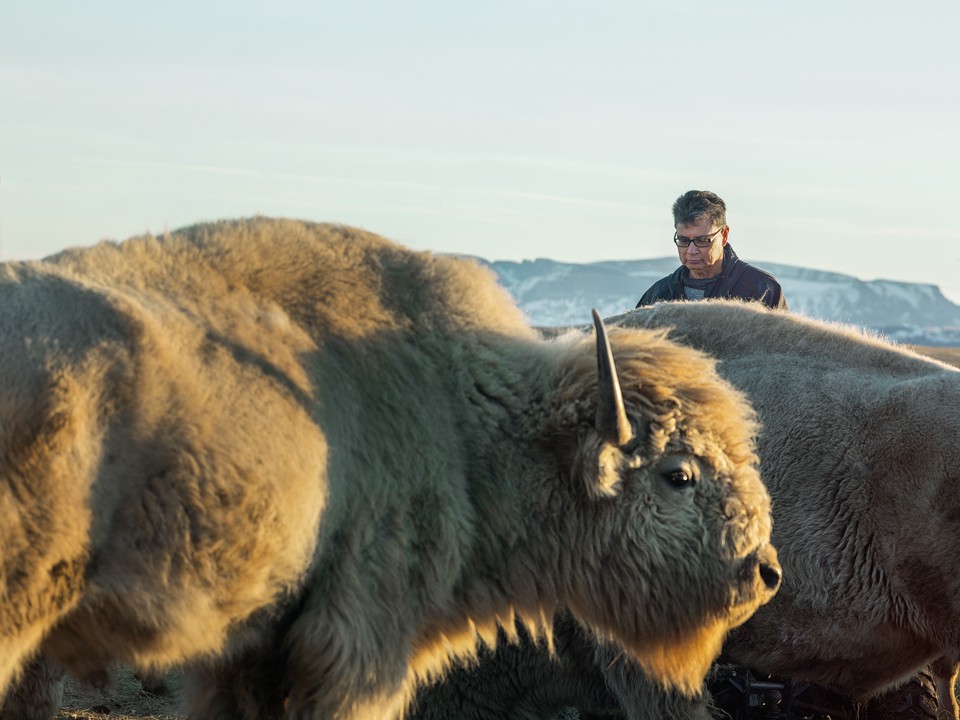
The first “park person” I met on my trip was Grant Geis, then the chief ranger at Theodore Roosevelt National Park (he has since retired). Geis is tall and broad-shouldered, with a rugged face and large, strong hands. He’d been at the park since 1998, when he started as a seasonal employee. “As soon as I hit Painted Canyon … I fell in love with it,” he told me, “and [I’ve] kind of been here ever since.”
Pretty much every person I talked with in the Park Service used the word love to describe the parks, the vistas, and their own roles as protectors of the land and its visitors. In my experience, that’s not a word most government employees use when talking about their job. I asked Geis about Teddy Roosevelt and his legacy. “He was a firm believer in the land of many uses, but at the same time trying to save something for future generations,” Geis replied. “It says something about his character when he was forward-thinking to that degree.” He also acknowledged Roosevelt’s imperfections and expressed support for cooperative relationships between parks and adjacent tribes.
The personal failings of people like Roosevelt are still codified in American policy. A lack of access to land—and the lack of power that such access would confer—undergirds the social ills that affect many Native peoples. But, at least in some places, American attitudes are changing. And in the parks, policies are changing too, albeit slowly, and in piecemeal fashion.
When I was a kid and my parents took my two siblings and me on our first trip out West, in the early ’80s, we stopped at Theodore Roosevelt, Custer Battlefield (now Little Bighorn), Yellowstone, and Grand Teton. Indians were barely mentioned on the signage, and I don’t remember meeting any Native rangers or even sensing that we existed as anything other than America’s past tense. But since the passage of the Native American Graves Protection and Repatriation Act, in 1990, tribes and parks (not to mention museums, galleries, and private collections) have drawn closer together in their efforts to preserve Native spaces and objects. Many tribes now have historic-preservation officers, who work with the parks.
Land use itself is also changing within the parks, to some degree. For instance, the Park Service has made it easier for Native people to harvest plants for traditional purposes, though typically they first have to submit a written request. And some parks allow us to hunt or trap within their borders.

Bottom left: Sterling HolyWhiteMountain, a university lecturer working to preserve the native Blackfeet language; Bottom right: Robert Hall, also active in language-preservation efforts, pictured at Two Medicine Lake, one of the tribe’s most sacred locations in Glacier National Park.
In some respects, ours is an era of Native resurgence. For all we have suffered, there remain 574 federally recognized tribes in the United States. When the first national parks were created at the end of the 19th century, only about 250,000 Native people were left in the U.S. Now there are more than 5 million Native Americans throughout the country, roughly equal to the number of Jewish Americans and millions more than the number of Muslim Americans.
Our survival hasn’t mattered only to us: As the efforts to assimilate us largely failed and we remained, mostly, in our homelands, Americans have gradually assimilated to our cultures, our worldview, and our modes of connecting to nature. The parks enshrine places, but they also emphasize and prioritize a particular way of interacting with the land. In the nation’s mythic past, the wilderness may have been a dangerous environment, something to be tamed, plowed under, cut down. But that way of relating to the land is no longer in vogue. For many Americans, our wild spaces are a solace, a refuge—cathedrals indeed. America has succeeded in becoming more Indian over the past 245 years rather than the other way around.
It took me a few days to hike the South Unit of Theodore Roosevelt. Unlike more congested parks such as Yellowstone and Yosemite, Roosevelt is quiet, so much so that it feels like a secret. I started in high, red, dusty hills, and descended through a series of washes and dry river bottoms. I keenly felt how far back in time I was traveling with each step. The trail rose past the petrified tree stumps of a swamp millions of years old and out onto a grassy plain, where the wind screamed through the grass, echinacea, aster, and goldenrod. I passed near cliffs where the tribes might once have funneled stampeding bison, causing them to fall to the hard earth below.
The day after I finished my hike, I had breakfast with Wendy Ross, the park superintendent, in Theodore’s Dining Room at the Rough Riders Hotel. I asked her whether Native people should be able to use the park differently than non-Natives, considering our longer tenure on the land, which had originally been part of the MHA’s tribal homeland. Why, I asked, couldn’t the MHA hunt the bison in the park? Ross said it was something of a slippery slope. If the park allowed Native people to hunt bison, the rest of the residents of North Dakota would throw a fit and, more troubling, the efforts of hunting groups to open up parks across the country to sport hunting would be greatly encouraged.
“The problem,” Ross said, is that “there are no protocols” nationally, and hence there’s much confusion. “Here at Roosevelt, I’ve told all of my staff: We let anybody in who says they’re coming in for ceremonial or spiritual purposes.” I have no doubt this is true. Ross seems to be a good leader and an ally to the tribes who live near Roosevelt. She spoke of reparations, of “providing what you can to people who used to use that area all the time, and then expanding that to other Native peoples.” She has been attending tribal meetings. Superintendents like Ross are changing the parks to better meet the needs of Native nations, but they can do only so much. So far, reparations are partial, ad hoc, and tenuous—always subject to reversal.
Native people need permanent, unencumbered access to our homelands—in order to strengthen us and our communities, and to undo some of the damage of the preceding centuries. Being Native is not so much a disposition or having a certain amount of blood running through one’s veins as it is a practice around which families and tribes are built. For a member of the Shoshone-Bannock Tribes, buying a bison burger at Whole Foods might satisfy their caloric needs, but being able to hunt and harvest bison, in keeping with their spiritual and cultural practices, feeds their culture and community. Native life was diminished when our land disappeared beneath our feet, and it is further diminished when the manner in which we access “public” lands is scripted by the government.
The preservation of these sublime places for future generations is of course crucially important, something Native Americans understand as deeply as anyone. But putting aside for a moment the interests of Native Americans—and notwithstanding the hard work and goodwill of many park employees—the parks show worrying signs of mismanagement. Myopic decisions have seemed to proliferate, and some protected natural spaces have become political footballs. Bears Ears National Monument, in southeastern Utah, was signed into being by President Barack Obama before he left office. One year later, President Donald Trump reduced Bears Ears by 85 percent, from 1.4 million acres to just over 200,000. This move left archaeological and sacred sites at the mercy of mining operations and motor vehicles. And while it is likely to be reversed by the Biden administration, possibly quite soon, it augurs poorly for the future.
Although the Department of the Interior will soon benefit from the leadership of Deb Haaland, who recently became the first Native American Cabinet secretary, it has typically lacked for innovation in recent years. As Jeff Ruch, a director of the nonprofit Public Employees for Environmental Responsibility, has written, “most parks merely ‘Xerox forward’ old plans, adjusting as they go.” Most of this is done without fresh thinking on conservation, development, and access.
National parks are withering as a result of overcrowding, habitat loss, and what Ruch calls a “science deficit.” Even as attendance has increased, park staff has been shrinking, as has the influence of scientists within the Park Service. Ruch’s assessment doesn’t make the Park Service sound like the protective arm of a powerful government safeguarding its “best idea.”
Parks, as they’ve existed for 149 years, have done a decent job of preserving the past. But it’s not clear that today’s model of care and custodianship best meets the needs of the land, Native people, or the general public. Nor is it clear that the current system will adequately ensure the parks’ future. That’s something Indians are good at: pushing ahead while bringing the past along with us. We may be able to chart a better way forward.

All 85 million acres of national-park sites should be turned over to a consortium of federally recognized tribes in the United States. (A few areas run by the National Park Service, such as the National Mall, would be excepted.) The total acreage would not quite make up for the General Allotment Act, which robbed us of 90 million acres, but it would ensure that we have unfettered access to our tribal homelands. And it would restore dignity that was rightfully ours. To be entrusted with the stewardship of America’s most precious landscapes would be a deeply meaningful form of restitution. Alongside the feelings of awe that Americans experience while contemplating the god-rock of Yosemite and other places like it, we could take inspiration in having done right by one another.
Placing these lands under collective Native control would be good not just for Natives, but for the parks as well. In addition to our deep and abiding reverence for wild spaces, tribes have a long history of administering to widely dispersed holdings and dealing with layers of bureaucracy. Many reservations are checkerboarded: Large parcels of reservation land are scattered and separated from one another. And much of the land within reservation boundaries is owned by a number of different interests—private, nontribal citizens; corporations; states; the federal government—that tribal leadership balances and accommodates. Through hard practice—and in the face of centuries of legal, political, and physical struggle—Indian communities have become adept at the art of governance. And tribes have a hard-earned understanding of the ways in which land empowers the people it sustains.
Transferring the parks to the tribes would protect them from partisan back-and-forth in Washington. And the transfer should be subject to binding covenants guaranteeing a standard of conservation that is at least as stringent as what the park system enforces today, so that the parks’ ecological health would be preserved—and improved—long into the future. The federal government should continue to offer some financial support for park maintenance, in order to keep fees low for visitors, and the tribes would continue to allow universal access to the parks in perpetuity. Bikers and toddlers, Instagram models and Tony Hawk—all would be welcome. We would govern these beautiful places for ourselves, but also for all Americans.
There is precedent for this kind of transfer. The indigenous peoples of Australia and New Zealand now control some of those countries’ most significant natural landmarks. For instance: Uluru, previously called Ayers Rock, was transferred to the Anangu decades ago. Thanks to legislation passed in 1976, nearly half of the Northern Territory of Australia has been returned to Aboriginal peoples. In 2017, New Zealand’s Māori were granted a greater role in the conservation of the Whanganui River, on New Zealand’s North Island. The public is still free to visit as before, but the Māori now have more oversight of the use of the river.
There is a precedent for this kind of transfer in America, too. In 1880, France began work on the Panama Canal, which the United States took over in 1904. Theodore Roosevelt (he keeps coming up) wanted to see it through, and so he worked out a deal with Panamanian nationalists, whereby the U.S. would receive the canal in exchange for help overthrowing the Colombian government. But in 1977, President Jimmy Carter and General Omar Torrijos of Panama signed an agreement that outlined the transfer of control of the canal to Panama. The canal was jointly managed by the two countries until 1999, when control reverted fully and finally to Panama. It doesn’t happen often, but the United States has given things back.
In 1914, the historian Frederick Jackson Turner argued that American democracy was forged on the frontier. It was there that the uniquely American mixture of egalitarianism, self-reliance, and individualism commingled to form the nation and its character. “American democracy,” he said, “was born of no theorist’s dream … It came out of the American forest, and it gained new strength each time it touched a new frontier.”
Turner was almost right. It wasn’t the frontier that made us as much as the land itself, land that has always been Native land but that has also come to be American. The national parks are the closest thing America has to sacred lands, and like the frontier of old, they can help forge our democracy anew. More than just America’s “best idea,” the parks are the best of America, the jewels of its landscape. It’s time they were returned to America’s original peoples.







